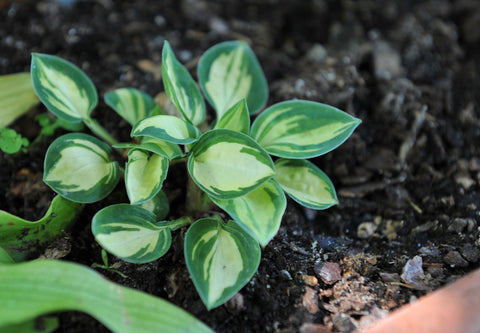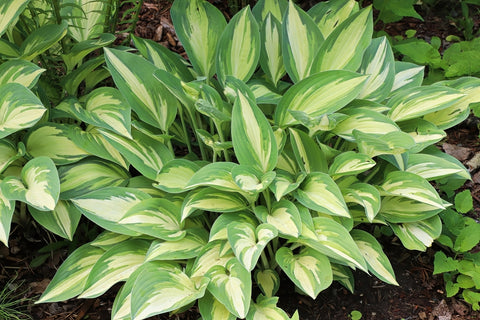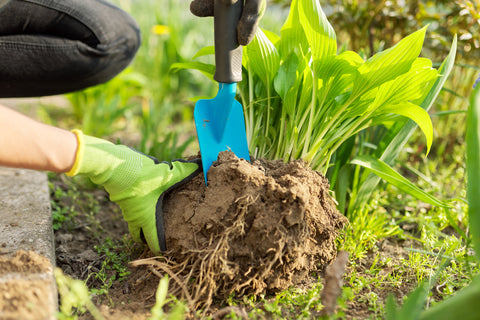Hosta plants, also known as plantain lilies, are versatile perennials that add beauty and elegance to any garden. With their wide range of varieties and captivating foliage, Hosta's are a favorite among gardeners. Whether you're a novice or an experienced gardener, this comprehensive guide will provide valuable insights into Hosta plants, including care tips and advice for successful growth. From exploring Hosta varieties to finding Hostas for sale, we'll cover everything you need to know about these stunning plants.
◼Types of Hosta Plants
Hosta plants come in a wide variety of sizes, leaf shapes, colors, and patterns. Let's explore some of the most popular types of hostas:
➡Miniature Hostas:
Miniature hostas are perfect for small gardens or containers. They typically grow up to 6 inches in height and form compact clumps.

➡Small Hostas:
Small hostas are slightly larger than miniatures, reaching heights of 6 to 12 inches. They are versatile and work well in borders or as edging plants. 'June' is a well-known small hosta with blue-green leaves edged in yellow, while 'Stiletto' features slender, lance-shaped green leaves.
➡Medium Hostas:
Medium hostas are popular choices for garden beds and borders. They typically grow between 12 and 18 inches in height. 'Francee' is a classic medium-sized hosta with dark green leaves and white margins. 'Sagae' is another notable variety with large, heavily textured blue-green leaves and creamy yellow margins.
➡Large Hostas:
Large hostas make a bold statement in any garden. They can reach heights of 18 to 30 inches or more. 'Sum and Substance' is a standout large hosta with gigantic chartreuse leaves that can grow up to 2 feet long. 'Empress Wu' is renowned for its huge, dark green foliage and impressive size.
➡Giant Hostas:
Giant hostas are the kings of the hosta world, reaching heights of 30 inches or more. These majestic plants create a dramatic focal point in larger gardens. 'Blue Angel' is a beloved giant hosta with large, blue-gray leaves that can span over 18 inches in width. 'Komodo Dragon' is another impressive giant hosta with deeply veined, dark green leaves.

➡Variegated Hostas:
Variegated hostas are prized for their stunning leaf patterns and colors. They can be found in various sizes, from miniatures to giants. Examples include 'Patriot' with its bold, dark green leaves edged in creamy white and 'Golden Tiara' with its green leaves splashed with bright yellow.

➡Fragrant Hostas:
Fragrant hostas add an additional sensory delight to the garden. These hostas produce sweetly scented flowers that can perfume the air. 'Guacamole' is a popular fragrant hosta with large chartreuse leaves and lavender flowers, while 'Royal Standard' features medium-sized green leaves and white fragrant blooms.
➡Edger Hostas:
Edger hostas are low-growing varieties perfect for lining pathways or garden borders. They form neat mounds and often have attractive foliage. 'Golden Scepter' is a compact edger hosta with bright gold leaves, while 'Curly Fries' displays narrow, tightly ruffled leaves in a unique twist.
Buy Herb Seeds
◼How to Plant & Care for Plantain Lilies
To plant plantain lilies, commonly known as hostas, and encourage healthy growth and beautiful hosta flowers, follow these steps:

✅Choose an Ideal Location:
Select a planting site that offers partial to full shade, as hostas prefer these light conditions. Ensure the area has well-draining soil and is away from areas prone to strong winds.
✅Prepare the Soil:
Before planting, prepare the soil by removing any weeds, rocks, or debris. Loosen the soil using a garden fork or tiller to a depth of about 12 inches. Incorporate organic matter like compost or well-rotted manure to improve soil fertility and drainage.
✅Dig the Planting Hole:
Dig a hole that is wide and deep enough to comfortably accommodate the hosta's root ball. The hole should be slightly larger than the size of the container or the spread of the plant's roots.
✅Plant the Hosta:
Gently remove the hosta from its container or handle the root ball with care. Place the plant in the center of the hole, ensuring that the crown (where the leaves meet the roots) is level with or slightly above the soil surface.
✅Backfill the Hole:
Fill the hole around the hosta with the amended soil, gently firming it to eliminate air pockets. Avoid compacting the soil too tightly, as it can hinder root growth. Leave a slight depression around the plant to help retain water.
✅Water Thoroughly:
After planting, water the hosta thoroughly to settle the soil and ensure good root-to-soil contact. Keep the soil evenly moist during the first few weeks, as hostas prefer consistent moisture. Water deeply rather than shallowly to encourage deep root development.
✅Mulch the Area:
Apply a layer of organic mulch, such as shredded bark or compost, around the base of the plant. Mulching helps retain soil moisture, suppresses weed growth, and regulates soil temperature. Leave a small space around the plant's crown to prevent rot.
✅Provide Adequate Care:
Hostas are relatively low-maintenance plants, but a few care practices can enhance their growth. Regularly water the plant, especially during dry spells, ensuring that the soil remains consistently moist but not waterlogged. Apply a balanced slow-release fertilizer in early spring to provide necessary nutrients. Remove any weeds that compete with the hosta for nutrients and water.
✅Encourage Hosta Flowers:
Most hosta varieties produce beautiful flowers in summer. To encourage blooming, ensure the plants receive adequate sunlight, as too much shade can limit flower production. Additionally, remove any spent flowers or seed pods to redirect the plant's energy towards foliage and future blooms.
Buy Plant Care Products
By following these planting and care instructions, you can enjoy the beauty of hosta flowers and foster healthy growth in your plantain lilies (hostas).
Read More-
Sanjeevani Plant: Care, Uses, and Medicinal Benefits
Dragon Fruit- Steps for picking the Ripe One!








